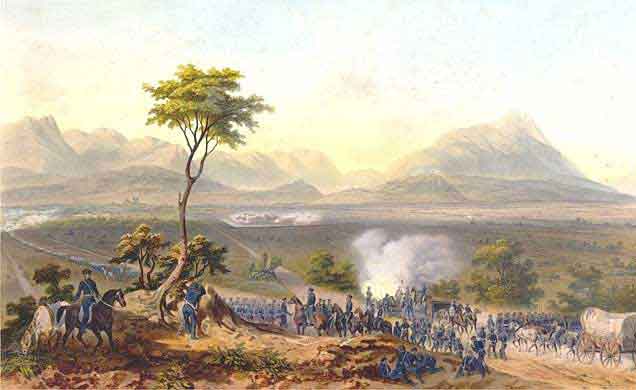Battle of Monterrey

General Taylor moved South into Mexico. His goal was the Mexican City of Monterrey. Capturing the city did not come easy, but after four days of fighting the city was captured the US troops
.
The U.S. would have been happy to end the war with New Mexico and California in American hands. However, the Mexicans were not accommodating. It became clear that the next step was to enter the area that was an undisputed part of Mexico. In July, General Taylor marched his army south, into Mexico. He first moved to the town of Camargo on the San Juan. Taylor's goal was to take over the Mexican town of Monterrey. General Pedro de Ampudia was the Mexican Commander in Monterrey. Ampudia had fortified the town as best as he could. Polk commanded a force of 3,200 regulars and 3,000 volunteers. He faced a Mexican force of 7,000 soldiers and another 3,000 volunteers.
Taylor decided on a flanking maneuver, sending Brigadier General Worth’s division to cut Monterrey off from the West. The maneuver worked. On the morning of the September 21st, General Worth attacked gaining control of the road. Meanwhile, Taylor's main forces engaged in what was supposed to be a diversionary attack. The diversionary attack was more costly than the flanking maneuver carried out by Worth. Worth's division expanded its control in the West two days later. By the third day, both Worth’s forces and Taylor's main force had entered the city. Fierce house-to-house fighting took place. Finally, the Mexicans faced an American threat to shell the cathedral in which they stored their ammunition. General Ampudia surrendered on the morning of the fourth day of the battle.
Following Taylor's victory, the question remained, what next? While Taylor had one decisive win, his victory had not come easily. It was clear that the Mexicans were going to keep fighting. The Mexican will to persist became particularly apparent after the Americans had allowed Santa Ana to return from exile to Mexico, believing that they had bribed him to accept peace. Santa Ana ignored the agreement once he arrived in Mexico City. It thus became clear, that to win the war the U.S. would have to actually capture the Mexican capital. Moving South from Monterrey seemed a difficult and costly direction. In addition, President Polk did not trust Taylor (who was a Whig). As a result, a plan was developed for an amphibious landing at Veracruz, followed by a march to Mexico City. To implement that plan Taylor was forced to give up many of his trained troops.
An American courier, who carried the American battle plans, was intercepted by the Mexicans. Thus, Santa Ana was aware of American plans to attack his capital– and the fact that Taylor’s army had been weakened. Santa Ana decided to attack Taylor’s army. He departed from Mexico City on January 28, 1847 and began a march North. It took Santa Ana three weeks to reach Taylor's position.
Taylor had been warned of the Mexican advance. As a result, Taylor moved his men into defensive positions in a valley called "La Angostura". Santa Anna (who had 15,000 men facing 4,500 mostly volunteers) did not think the American were ready to take him on. He demanded that Taylor surrender. Taylor responded: “Tell Santa Ana to go to Hell”. On February 22nd the battle began. For two days the sides battled on in heavy fighting. The Mexicans almost broke through a number of times. However, Taylor managed to rally his troops. Finally, Santa Ana was forced to withdraw.
 >
>